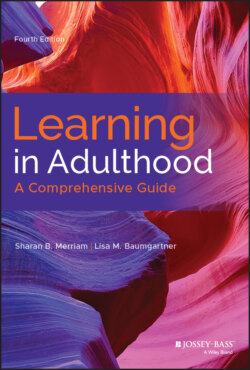Читать книгу Learning in Adulthood - Sharan B. Merriam - Страница 54
Participation Equals Formal Learning
ОглавлениеIn writing this chapter on participation we would have liked to present as comprehensive a picture as possible. However, as we stated earlier, nearly all of the studies are of participation in formal institutionally sponsored programs. Yet we know that adults engage in learning activities sponsored by community-based nonformal groups. Further, adults learn informally on their own. Even in business and industry it has been estimated that upwards of 75% of learning in the workplace is informal (Bancheva & Ivanova, 2015).
What accounts for this bias in participation studies? It has to do in part with the ease of collecting information from educational institutions; in part it is due to adult learners themselves not recognizing the informal learning embedded in their everyday lives. And certainly the bias in part has to do with policy and funding. Although the field is proud of its service orientation and the voluntary nature of participation, in reality what is offered cannot be uncoupled from the question of who finances the various adult learning opportunities. And the answer to this question of who finances adult education is easier to find in reference to formal adult education.
In North America, there are many providers of formal learning opportunities, including government at all levels, employers, educational institutions, and community institutions such as libraries. Because much of the expenditure for this form of learning is hidden under a variety of budgetary labels—at one time more than 270 federal programs alone had some adult learning component (Griffith & Fujita-Starck, 1989)—it is difficult to measure the relative financial power of various providers.
To complicate the matter, what is offered at any particular time “will almost inevitably relate to the pressures generated in the social system. Social pressures act in such a manner as to create an imbalance in the system to which institutions, other than that generating pressure, respond by seeking to restore the system to some form of equilibrium” (Jarvis, 1986, p. 57). Institutions are currently being pressured to respond to the issues of an increasingly diverse workforce, technological obsolescence, and health threats such as obesity. This notion of mobilizing institutions in the service of maintaining social equilibrium is but one explanation for the shifts in curriculum emphasis.
Crowther (2000) points out that it could be argued that the monopoly of formal adult education is being challenged “by developments in experiential learning, the growth of new educational technologies, distance learning and procedures such as the accreditation of prior learning” (p. 485). He goes on to ask, “Are these not examples of a more democratic, pluralistic, learning process which both facilitates access and disperses control over the curriculum?” (p. 485). However, these mechanisms of dealing with and recognizing informal experiential learning can also be seen as “reaffirming, rather than undermining, the dominant assumptions about control over definitions of educationally relevant knowledge” (p. 485). In other words, when the recognition of informal learning is tied to the formal system as in accreditation of prior learning, control still rests with the system that has predetermined what counts as learning. That the formal system will serve its own interests is underscored by an interesting article in Training & Development about “free agent learners” (Caudron, 1999). Acknowledging the rise of employees learning on their own, Caudron warns that “companies have to be willing to accept the new ideas such employees are bringing to work” and that “free agent learners threaten corporate governance because the more that people learn, the more competent and confident they become” (p. 30). Speaking of the skills and competencies needed for the twenty-first century, Xanthoudaki (2015) observes that today's learners “decide what and how to learn, emerging as expert in their own right. This is not because we suddenly recognize the value of personalized learning, but because it seems to be the only way to face change.” Indeed, “opportunities for personalized, self-motivated education move away from the model of learning organized around stable, usually hierarchical institutions” (p. 249).
Participation equals formal learning because of ease of measurement but also because the formal system controls what gets “counted” as adult education. In a pluralistic society such as ours, there is no single answer to the question of who decides what learning opportunities to offer. The field is indeed complex with “demographic changes, globalization, and the intertwined explosion of technology and information” all contributing to the “expansion of adult education” in terms of providers, learners, and sites of learning (Ross-Gordon, Rose, & Kasworm, 2017, p. 27). In reality, for formal learning programs at least, decisions are made by those who pay—whether that means the learners themselves, government, employers, or educational institutions. And those who pay are in positions of power to determine which social pressures will be addressed and how those responses will be structured. Those not in positions of power rarely decide what learning opportunities are offered. Their role is limited to deciding whether to participate.
